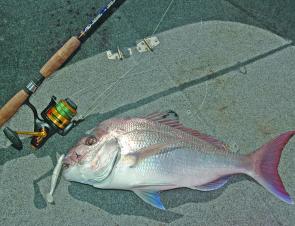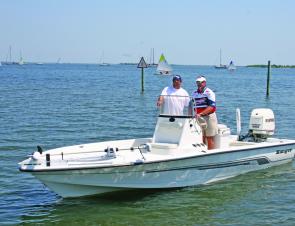When it comes to boating, it is a luxury to be able to pick and choose between a variety of different boats. With a few boats of my own, my family’s boats, factory boats and fishing friends’ boats at my disposal, I am usually lucky enough to pick a boat that is not only best suited for a specific technique or species, but also for a specific location.
The following are some observations of what you might choose in a boat for cast and retrieve lure fishing for snapper – depending on where you fish.
For fishing areas like Smiths or Hutchies reefs, the best boats are the true walk arounds, with the comfort of a small cabin and serious room down the sides and around the front for an extra mate or two to go fishing and share the fuel bill. These style of boats are also perfect for families. Our family boat in Moreton Bay is a 29ft Aussie built Blackfin walk around and we easily fish five anglers out of it, and can fit six on board with a bit of extra planning.
Walk arounds, like centre consoles, are much better suited to casting lures to snapper, mackerel and tuna than cabin or runabout style boats.
If the fishing spot is a decent run from the boat ramp then a fast boat becomes extremely desirable, probably something along the lines of a twin outboard engine walk around or centre console. At the boat shows last season in South East Queensland there was even a triple engine offshore rig from Gold Rush of the Gold Coast.
Similarly if you are running the South Passage bar from a big walk around boat in the Haines Patriot or Boston Whaler class then it is an advantage to have twin engines, but not necessarily just for the reliability. My real preference for two engines is that the twin outboards (with counter-rotating props and gearboxes) effectively give you twin rudders in the water. This has always seemed to give me better steering and tracking than single legs when you are running with the waves. With boats getting up towards three tones, in my opinion, this steering benefit becomes a serious consideration with all that weight hanging out in front of the water and down the front of a swell.
Of course some spots can be brought closer to the ramp if you trailer closer to them. Hence trailer ability may also be a factor.
For shallow reefs with very shallow structure like the Southern Bay Islands, Brisbane River, Pumicestone Passage, and Redcliffe Reef a boat with a bow mount electric is my preference. When you need to gently and quietly manoeuvre to avoid rocks or a reef wall, or to inch towards visible, fish holding structure then a bow mount electric is the go. The boats that go with this include 14-17ft alloy boats, simon-pure American style bass boats and the boat that I reckon is the best for South East Queensland saltwater as well as the freshwater lakes throughout the entire length of the eastern seaboard, which is the American flats boat.
Another style of craft that many Aussies may first turn their nose up at (I’ve discussed these boats with a few readers) is the style that they call a bay boat in Florida in the USA. The bay boat is basically similar to an Aussie style centre console around 18-24ft long but with lower sides than the typical Aussie centre console, always with a self-draining floor (which in some ways offsets the low sides) and full positive flotation. Think of a Yamaha longboat without the rails and you have one of the closest local examples. The bay boat’s low sides reduce the wind and afford better manoeuvrability behind a 36volt bow mount electric motor. It wouldn’t surprise you that the American bay boats run serious horsepower – take a look at the photos.
Mud Island is a prime example such a location, and any old boat will do as long as it is seaworthy for the location. Tiller steer quick start dinghies, traditional half cabs and runabouts all suit this type of location; as do the offshore walk around and the saltwater bay and flats boats.
Apart from seaworthiness, a major requirement for us when fishing these shallow reefs is the boat’s ability to be started quickly, which enables us to fire up immediately after a hookup with a big fish and move the boat away from the reef where we can then fight the fish in a location less likely to get our line damaged by the reef.
You can’t use engines to hold position as you drift around small isolated ‘one-hit’ wonder hotspots in shallower waters, because the engines will spook the fish. But you need to manoeuvre to ensure your drift goes within casting distance of the small piece of fish holding structure on the bottom. Hence an electric motor becomes a valuable aid. And with an electric motor comes a particular style of boat, low sides being common amongst purpose lure casting craft. An example is the Kapitan Neilson wreck, which is on the bottom in around 12m of water.
This genre is not my forte, although I have fished some of the spots that I’ve mentioned in this article out of paddle craft going back I think eight or so years, particularly around Redcliffe. There is a lot yet to come from this little boat concept, particularly when mother shipping gets underway. Right now they are a great way to fish close in spots with stealth. Redcliffe as well as the close in Bay Islands and rivers that run into the bay are all extremely viable kayak snapper fisheries. Another concept would be four-wheel driving by barge to one of the big islands and launching off the inside beach.
I’ve long been a fan of the Aussie side console alloy boats from 15-17ft long. Essentially today’s 17ft alloy boat is the 15ft of the past, but now with about 2ft of pod extension to give the more seaworthy full transom height.
This style of craft has actually seen a lot of evolution, which is what I like to see in boats. I do have something to compare with as there have been two 1970’s 15ft Stacers in our family. The modern versions with a modified bow such as those with a casting platform incorporated, a full height transom and the Quinnie’s flared bow, have always been as all-round as you can get for southern Queensland. When the wind is up you stay inshore and when the waters are flat you can slip offshore throughout the bay, with the reefs around Cape Moreton well within the boat’s scope. But wait, there is even more to say about this boat, powered by a 60hp Yamaha four-stroke they are a very fuel efficient package.
The wrong thing to do is to put a heap of horsepower on an all-rounder and to thump it out in borderline offshore conditions – and I mean borderline for comfort not seaworthiness – push an alloy boat hard on long runs and you’ll pay for it in chiropractor bills. On the other hand if you go to a heavier boat for better ride in the rough you’ll need more horsepower plus more fuel, a bigger tow vehicle and you’re also likely to reduce your skinny water viability.
So there you have it – lots of options to choose from – and for sure the debates between you and your mates go will round in circles… one of each maybe?
1.
Mum with a tuna caught lure casting from the front of a 17ft Quinnie console boat – centre consoles offer the option of easier casting to schooling fish; and you have more fishing room.
2.
Mum with a lake barra caught this time from the stern of the same 17ft Quinnie console boat – this style of boat is the true all rounder of the SEQ scene.
3.
A snapper caught out from Elliot Heads from the same 17ft Quinnie.
4.
While not yet common in Australia, saltwater flats boats are truly a great option for Moreton Bay waters –look at that blend of casting deck and cockpit.
5.
This is the Bay Boat concept with low sides (for low windage) and a bow mount up front – they are basically similar to an Aussie centre console but with lower sides and with electric steer ability.
6.
The side view of a typical 6-7m bay boat centre console – note the engine size; there's 250 factory horsepower under that E-Tec cowling.
Reads: 5170









